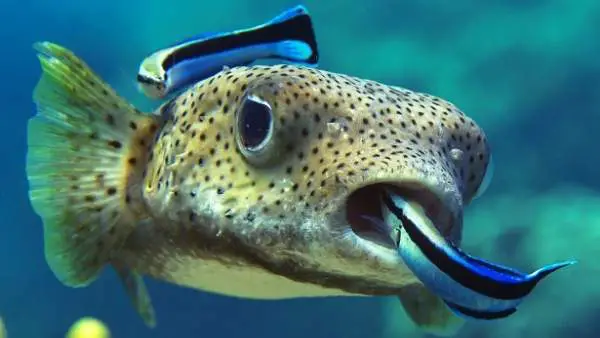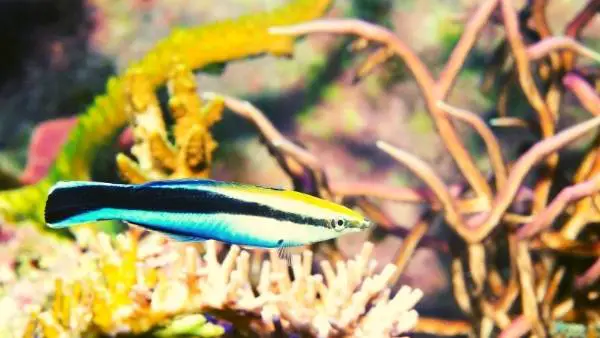The Cleaner Wrasse, or otherwise known as the Labroides dimidiatus (scientific name) is another awesome addition to the Wrasse fish species, there are several different names for the Cleaner Wrasse; the Bluestreak Cleaner Wrasse, which could well be the most popular name of them all, the Common Cleaner Wrasse, and the Striped Cleaner Wrasse.
These cleaner fish can be found in and around coral reefs, ranging from Eastern Africa to French Polynesia, and even the Red Sea. Cleaner Wrasses are a brilliant addition to any tank and community, after all, your other fish need a good clean now and again, right? They are brilliant little reef fish and add value to almost all aquariums.
What is so interesting and perhaps beneficial at the same time with Cleaner Wrasse fish is that they won't require as much food as their other tankmates, as they spend a lot of their time feeding off the dead scales, slimes, and parasites found on the other fish within your aquarium. They still, however, need to be fed regularly with vitamin and mineral-rich foods in order to maintain a healthy and balanced diet.

Helpfulness
In addition, the Cleaner Wrasse should certainly be one of the last fish to be introduced to your tank due to their incredibly unique and specialist feeding habits. As well as being incredibly helpful, they are amazingly intelligent as well, they will set up a cleaning station within your saltwater aquarium in order to attract other fish to come for a clean and subsequent meal for the Wrasses.
They are such an asset to any community that even larger fish and predatory fish have been known to let them clean the inside of their mouths and inside their gills!
Feeding Requirements
Now despite them not being fussy eaters when it comes to parasites and other undesirable bacteria eaten off other fish, they have a rather big reputation for being poor at adjusting to a diet of frozen, flaked, and pellet food, which can be an issue and will likely consume much of your time as a hobbyist. However, like any other fish, especially Wrasses, they can, and with patience and consistency will likely adjust. If your cleaner cannot adjust and adapt to certain foods, you will run the risk of your Cleaner Wrasse slowly starving to death.
Due to their helpful and inquisitive nature, the Labroides dimidiatus is a very active fish and perhaps will become one of the most social fish within your community. Once they are established and settled, they will spend the majority of their time swimming in the open and exploring the entire tank.
They enjoy playing and swimming along and up and down the glass of your tank, they are great finger followers and will provide you with an abundance of entertainment and joy. During the night they tend to hide within rocks or miniature caves or bury themselves in the substrate, which has to be soft for this exact reason.
Special Tank Requirements and Additional Information
- They require a minimum tank size of 55 Gallons, which is 208 Liters.
- The Wrasse tend to be pretty tough fish, and the Cleaners are no different, they are prone to no diseases.
- They are not particularly compatible with beginners, in fact, an expert hobbyist with good experience and an established tank would be perfect for this small fish.
- A fully grown adult will likely grow to 4-5 inches in length (11-13 cm).
- They are small fish with the front half of their body being light orange and the rear part blue.
- They also have a navy blue band along their body.
- They are reef fish, meaning they are definitely reef compatible.
- Despite what we mentioned previously regarding predators, and more specifically the
- Wrasses cleaning them. Despite being somewhat known for this, it is not advised to keep them in a predator environment as you don't want these beauties going missing!
All in all, they are a fairly hard fish to care for, although being self-sufficient at times with their feeding habits, their requirements, and lack of appetite at times can certainly be a detriment to them.
Tank Requirements
- The tank's pH level must be between 8.1 to 8.4.
- The temperature of the tank should be between 24°C to 27°C (80.6°F).
- They don't require any specific tank level as they will go everywhere within the tank!
- In addition, they require a plethora of hiding spaces.
- They are also recommended to be living independently, keep them singularly if you can.
When it comes to feeding, the Cleaner Wrasse has some somewhat special requirements, perhaps the most out of any marine fish that you will have to enter your community. They tend to live off predominantly parasites and dead fish scales. You will need to ensure that your tank has enough fish for the Cleaners to do their work and subsequently support their dietary requirements.

Due to the fish being incredibly fussy and unwilling when it comes to actual feeding (with pellets, frozen, and flake foods), it is important to ensure that your Cleaner adapts to its environment quickly and well, this is the best way of guaranteeing your fish will eat the correct nutritious foods.
They are carnivores and require a varied, yet balanced diet to maintain a healthy life. They are also quick eaters, so it is important during feeding times to ensure the rest of the community is receiving the correct amount of food.
Acclimatization
In order to properly acclimatize your fish, you must place it in a bucket, and proceed to drip acclimate for around 1 hour (60 minutes) at a consistent rate of 3 drips per second. This will bring their water parameters in line with your tanks.
Once your Cleaner has been drip acclimated, you must catch it with a net and place it slowly and gently into your tank and its new home. It is crucial that none of the water that your fish originally came in gets into your tank. In addition to this, keeping the lid securely fastened is important too, the Cleaner Wrasses have been known to jump when initially introduced to aquariums.
So, in conclusion, only get a Cleaner Wrasse if you are an experienced hobbyist ({or have done plenty of research) and are prepared to take on a new and unique challenge. They are an incredibly fun and awesome addition to any reef aquarium, and, if looked after correctly, will benefit your tank tremendously.
